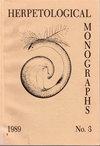Structural and Heterochronic Variations During the Early Ontogeny in Toads (Anura: Bufonidae)
IF 1
2区 生物学
Q3 ZOOLOGY
引用次数: 8
Abstract
Abstract: In recent decades, a renewed interest in comparative studies of embryonic ontogeny in anurans is taking place. Toad embryos are often employed as model organisms, and scarce attention has been put on interspecific variations. In this work we analyze the development of transient embryonic and larval structures in 21 species in five genera of Bufonidae. These species vary in their ovipositional mode and the type of environments where the embryos and tadpoles develop, including ponds, streams, and axils of leaves of terrestrial or epiphytic plants. Comparative anatomical studies and sequence heterochrony analyses show that primary morphological variations occur in the morphology at the tail-bud stage, the arrangement and development of the external gills, adhesive gland type and division timing, growth of the dorsal hatching gland on the head, configuration of the oral disc, emergence and development of the hind limbs, and presence of the abdominal sucker. Some of these transformations are best explained by phylogeny (e.g., early divergent taxa of bufonids have embryos with kyphotic body curvature, Type C adhesive glands, and a very small third pair of gills). Other traits might be correlated with reproductive modes (e.g., phytotelmata embryos hatch comparatively late and show an accelerated development of hind limbs). Because these actual variations are not well studied (e.g., less than the 10% of the known diversity of bufonids has been studied from this perspective), comprehensive analyses are required to interpret character evolution and the relationship with reproductive modes within the family.蟾蜍(无尾目:蟾蜍科)早期个体发育过程中的结构和异时变异
摘要:近几十年来,人们对无尾动物胚胎个体发生的比较研究重新产生了兴趣。蟾蜍胚胎通常被用作模式生物,但很少关注种间变异。本文分析了蟾科5属21种瞬态胚胎和幼虫结构的发育。这些物种的产卵方式和胚胎和蝌蚪发育的环境类型各不相同,包括池塘、溪流和陆生或附生植物的叶腋。比较解剖学研究和序列异时性分析表明,主要形态变异发生在尾芽期形态、外鳃的排列发育、粘附腺类型和分裂时间、头部背孵化腺的生长、口盘的形态、后肢的出现和发育以及腹部吸盘的出现。其中一些转变最好用系统发育来解释(例如,早期分化的蟾类类群具有后凸体曲率的胚胎,C型粘着腺和非常小的第三对鳃)。其他性状可能与繁殖方式有关(例如,植骨龟胚胎孵化相对较晚,后肢发育较快)。由于这些实际的变异并没有得到很好的研究(例如,从这一角度研究的已知bufonids多样性不到10%),因此需要进行全面的分析来解释性状进化及其与家庭内生殖模式的关系。
本文章由计算机程序翻译,如有差异,请以英文原文为准。
求助全文
约1分钟内获得全文
求助全文
来源期刊

Herpetological Monographs
生物-动物学
CiteScore
5.40
自引率
0.00%
发文量
2
审稿时长
>12 weeks
期刊介绍:
Since 1982, Herpetological Monographs has been dedicated to original research about the biology, diversity, systematics and evolution of amphibians and reptiles. Herpetological Monographs is published annually as a supplement to Herpetologica and contains long research papers, manuscripts and special symposia that synthesize the latest scientific discoveries.
 求助内容:
求助内容: 应助结果提醒方式:
应助结果提醒方式:


